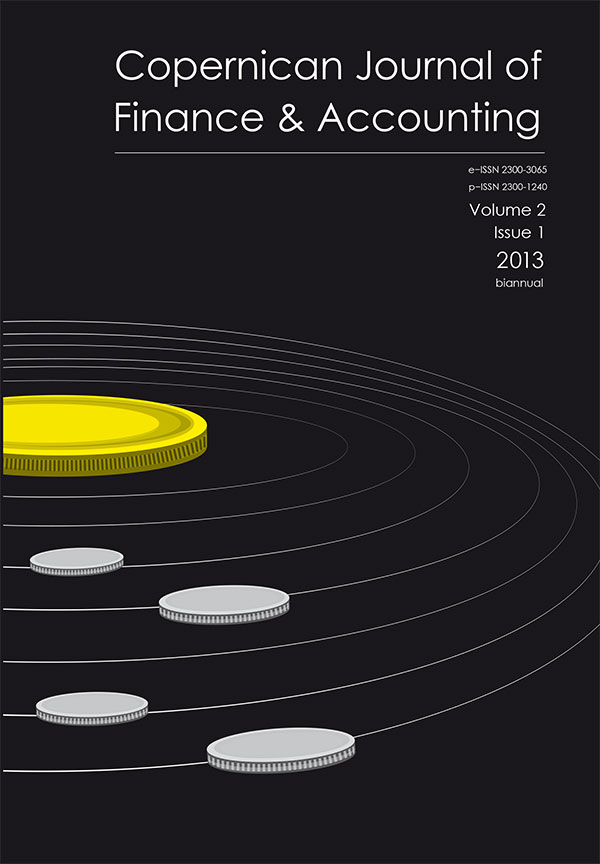The role bonds in financing climate resilient economy
DOI:
https://doi.org/10.12775/CJFA.2013.011Keywords
climate bond, environmental finance, low-carbon economyAbstract
Climate bonds are a new category of climate-related financial products in environmental finance. The validity of the emergence of climate bond market seems reasonable to attract private capital to finance climate-resilient economy and to make the recognition of green investment easier for potential investors. Investments in low-carbon assets and technology to meet the Kyoto Protocol targets or investments to adopt to extreme weather conditions are just examples of sources of the capital needed. Developing the potential of green bond market has not been fully exploited so far. In the future, the most important determinants to stimulate the growth of the market will be green standardizations that are currently under construction. Positive outlook also results from existence of institutional investors represents tens of trillion USD and intends to incorporate climate change into investment strategies. Not without significance is the fact that green sukuk will enlarge the spectrum of climate-related financial products.
References
Global Investor Statement on Climate Change (2013), http://www.iigcc.org/iigcc- -investor-statement (access: 12.05.2013).
Agrawala S. et al. (2011), Private Sector Engagement in Adaptation to Climate Change: Approaches to Managing Climate Risks, OECD Environment Working Papers, no. 39, OECD Publishing, http://dx.doi.org/10.1787/5kg221jkf1g7-en.
Bennett M., Iqbal Z. (2011), The role of Sukuk in meeting global development challenges, [in:] Global Growth, Opportunities and Challenges in the Sukuk Market, S. Jaffer (ed.), http://treasury.worldbank.org/cmd/pdf/Euromoney_2011_The_role_of_Sukuk_in_ meeting_global_developement_challenges.pdf.
BIS (Bank for International Settlements) (2013), https://www.bis.org/statistics/secstats.htm (access: 12.05.2013).
Boyde E. (2012), Nikko AM World Bank green bond funds raise $650m, “Financial Times”, http://www.ft.com/intl/cms/s/0/432836bc-4fe3-11e0-a37e-00144feab49a.html#axzz2DFYRSQBf.
CBI (Climate Bond Initiative) (2011), Climate Bond Standard, version 1.0 – prototype. The Climate Bonds Initiative, http://standards.climatebonds.net/ (access: 14.05.2013).
Croce R. D., Kaminker R. C., Stewart F. (2011), The Role of Pension Funds in Financing Green Growth Initiatives, OECD Publishing, Paris, http://dx.doi.org/10.1787/5kg58j1lwdjd-en.
Daiwa Securities (2010), Yamamoto S., Emerging investment category capturing retail investors. Impact Investing in Japan (presentation).
DIFC (Dubai International Financial Centre) (2009), Dubai International Financial Centre Sukuk Guidebook, http://www.difc.ae/sites/default/files/attached/5712/6707/6429/islamic.pdf.
Doom J., Buhayar N. (2012), Buffett Plans More Solar Bonds After Oversubscribed Deal, Bloomberg, http://www.bloomberg.com/news/2012-02-29/buffett-plans-moresolar- bonds-after-oversubscribed-topaz-deal.html.
Dziawgo L. (1997), Papiery wartościowe w ochronie środowiska, Dom Organizatora, Toruń.
Dziawgo L. (2003), Eco-Offers of Banks and Investment Funds. Poland and International Trends, UMK, Toruń.
The Europe 2020 Project Bond Initiative – Innovative infrastructure financing (2012), http://www.eib.org/about/news/the-europe-2020-project-bond-initiative.htm.
Green Investment Bank (2013), http://www.greeninvestmentbank.com/ (access: 13.05. 2013).
IFC thematic bonds (2013), http://www1.ifc.org/wps/wcm/connect/40d57a004851 d833b735fffc046daa89/Green+Bond+April+2013.pdf?MOD=AJPERES.
Inderst G., Kaminker Ch., Stewart F. (2012), Defining and Measuring Green Investments: Implications for Institutional Investors’ Asset Allocations, OECD Working Papers on Finance, Insurance and Private Pensions, no. 24, OECD Publishing.
Kaminker C., Stewart F. (2012), The Role of Institutional Investors in Financing Clean Energy, OECD Working Papers on Finance, Insurance and Private Pensions, no. 23, OECD Publishing, http://dx.doi.org/10.1787/5k9312v21l6f-en.
Kidney S. (2012), Green Sukuk Working Group launched to support finance for climate change investment projects, Climate Bonds Initiative, http://climatebonds.net/2012/03/green- sukuk-working-group-launched-to-support-finance-for-climate-change-investmentprojects/.
OnIslam & Newspapers (2012), Green sukuk, http://www.onislam.net/english/news/ middle-east/456109-middle-east-gets-green-sukuk.html (access: 16.05.2013).
Qualified Energy Conservation Bonds (“QECBs”) & New Clean Renewable Energy Bonds (“New CREBs”), U.S. Department of Energy, http://www1.eere.energy.gov/wip/ pdfs/qecb_creb_primer.pdf.
Richardson B. J. (2011), Sovereign Wealth Funds and the Quest for Sustainability: Insights from Norway and New Zealand, Nordic Journal of Commercial Law, http://ssrn.com/abstract=1972382.
Robins N., Knight Z. (2012), Bonds and climate change: the state of the market in 2012, HSBC Global Research.
SEB (Skandinaviska Enskilda Banken) (2013), http://merchantbanking.sebgroup.com/ our-services/markets/fixed-income-and-dcm/green-bonds/ (access: 14.05.2013).
UNEP FI (2012), Principles for Sustainable Insurance, http://www.unepfi.org/psi/.
Więckowska M. (2013), Zarządzanie ryzykiem ekologicznym determinowanym działalnością antropogeniczną w zakresie emisji dwutlenku węgla do atmosfery, “Ekonomia i Środowisko”, nr 1 (44).
The World Bank (2012), The World Bank Green Bond. Fact sheet, http://treasury.worldbank. org/cmd/pdf/WorldBankGreenBondFactSheet.pdf.
Downloads
Published
How to Cite
Issue
Section
Stats
Number of views and downloads: 974
Number of citations: 0



